Olivine and Whole-Rock Geochemistry Constrain Petrogenesis and Geodynamics of Early Cretaceous Fangcheng Basalts, Eastern North China Craton
Abstract
1. Introduction
2. Background and Sample Description
3. Analytical Methods
3.1. Whole-Rock Analyses
3.2. Olivine Analyses
4. Results
4.1. Whole-Rock Geochemistry
4.2. Olivine Geochemistry
5. Discussion
5.1. Magmatic Processes During Crustal Transit
5.2. Origin and Nature of the Mantle Source
5.3. Hybrid Lithology in Mantle Source
5.4. Reconstruction of Primary Melts and P-T Formation Conditions
5.5. Geodynamic Implications
6. Conclusions
Supplementary Materials
Author Contributions
Funding
Data Availability Statement
Acknowledgments
Conflicts of Interest
References
- Carlson, R.W.; Pearson, D.G.; James, D.E. Physical, Chemical, and Chronological Characteristics of Continental Mantle. Rev. Geophys. 2005, 43, 1–24. [Google Scholar] [CrossRef]
- Lee, C.T.A.; Luffi, P.; Chin, E.J. Building and Destroying Continental Mantle. Annu. Rev. Earth Planet. Sci. 2011, 39, 59–90. [Google Scholar] [CrossRef]
- Zhu, R.; Zhao, G.; Xiao, W.; Chen, L.; Tang, Y. Origin, Accretion, and Reworking of Continents. Rev. Geophys. 2021, 59, e2019RG000689. [Google Scholar] [CrossRef]
- Xu, Y.G. Thermo-Tectonic Destruction of the Archaean Lithospheric Keel beneath the Sino-Korean Craton in China: Evidence, Timing and Mechanism. Phys. Chem. Earth Part A Solid Earth Geod. 2001, 26, 747–757. [Google Scholar] [CrossRef]
- Yang, J.H.; Wu, F.Y.; Wilde, S.A.; Belousova, E.; Griffin, W.L. Mesozoic Decratonization of the North China Block. Geology 2008, 36, 467–470. [Google Scholar] [CrossRef]
- Wu, F.-Y.; Yang, J.-H.; Xu, Y.-G.; Wilde, S.A.; Walker, R.J. Destruction of the North China Craton in the Mesozoic. Annu. Rev. Earth Planet. Sci. 2019, 47, 173–195. [Google Scholar] [CrossRef]
- Griffin, W.L.; Andi, Z.; O’Reilly, S.Y.; Ryan, C.G. Phanerozoic Evolution of the Lithosphere beneath the Sino-Korean Craton. Mantle Dyn. Plate Interact. East Asia 1998, 27, 107–126. [Google Scholar] [CrossRef]
- Gao, S.; Rudnick, R.L.; Carlson, R.W.; McDonough, W.F.; Liu, Y.S. Re-Os Evidence for Replacement of Ancient Mantle Lithosphere beneath the North China Craton. Earth Planet. Sci. Lett. 2002, 198, 307–322. [Google Scholar] [CrossRef]
- Zheng, J.; Griffin, W.L.; O’Reilly, S.Y.; Yang, J.; Li, T.; Zhang, M.; Zhang, R.Y.; Liou, J.G. Mineral Chemistry of Peridotites from Paleozoic, Mesozoic and Cenozoic Lithosphere: Constraints on Mantle Evolution beneath Eastern China. J. Petrol. 2006, 47, 2233–2256. [Google Scholar] [CrossRef]
- Zhang, H.F.; Goldstein, S.L.; Zhou, X.H.; Sun, M.; Zheng, J.P.; Cai, Y. Evolution of Subcontinental Lithospheric Mantle beneath Eastern China: Re-Os Isotopic Evidence from Mantle Xenoliths in Paleozoic Kimberlites and Mesozoic Basalts. Contrib. Mineral. Petrol. 2008, 155, 271–293. [Google Scholar] [CrossRef]
- Chu, Z.Y.; Wu, F.Y.; Walker, R.J.; Rudnick, R.L.; Pitcher, L.; Puchtel, I.S.; Yang, Y.H.; Wilde, S.A. Temporal Evolution of the Lithospheric Mantle beneath the Eastern North China Craton. J. Petrol. 2009, 50, 1857–1898. [Google Scholar] [CrossRef]
- Wu, F.Y.; Lin, J.Q.; Wilde, S.A.; Zhang, X.; Yang, J.H. Nature and Significance of the Early Cretaceous Giant Igneous Event in Eastern China. Earth Planet. Sci. Lett. 2005, 233, 103–119. [Google Scholar] [CrossRef]
- Xu, Y.G.; Li, H.Y.; Pang, C.J.; He, B. On the Timing and Duration of the Destruction of the North China Craton. Chin. Sci. Bull. 2009, 54, 3379–3396. [Google Scholar] [CrossRef]
- Zhu, R.; Chen, L.; Wu, F.; Liu, J. Timing, Scale and Mechanism of the Destruction of the North China Craton. Sci. China Earth Sci. 2011, 54, 789–797. [Google Scholar] [CrossRef]
- Zhu, G.; Lu, Y.; Su, N.; Wu, X.; Yin, H.; Zhang, S.; Xie, C.; Niu, M. Crustal Deformation and Dynamics of Early Cretaceous in the North China Craton. Sci. China Earth Sci. 2021, 64, 1428–1450. [Google Scholar] [CrossRef]
- Zheng, Y.; Xu, Z.; Zhao, Z.; Dai, L. Mesozoic Mafic Magmatism in North China: Implications for Thinning and Destruction of Cratonic Lithosphere. Sci. China Earth Sci. 2018, 61, 353–385. [Google Scholar] [CrossRef]
- Liu, L.; Liu, L.; Xu, Y.-G. Mesozoic Intraplate Tectonism of East Asia Due to Flat Subduction of a Composite Terrane Slab. Earth-Sci. Rev. 2021, 214, 103505. [Google Scholar] [CrossRef]
- Ma, Q.; Xu, Y.-G. Magmatic Perspective on Subduction of Paleo-Pacific Plate and Initiation of Big Mantle Wedge in East Asia. Earth-Sci. Rev. 2021, 213, 103473. [Google Scholar] [CrossRef]
- Fan, W.M.; Zhang, H.F.; Baker, J.; Jarvis, K.E.; Mason, P.R.D.; Menzies, M.A. On and off the North China Craton: Where Is the Archaean Keel? J. Petrol. 2000, 41, 933–950. [Google Scholar] [CrossRef]
- Huang, X.; Xu, Y. Thermal State and Structure of the Lithosphere beneath Eastern China: A Synthesis on Basalt-Borne Xenoliths. J. Earth Sci. 2010, 21, 711–730. [Google Scholar] [CrossRef]
- Menzies, M.A.; Xu, Y. Geodynamics of the North China Craton. Mantle Dyn. Plate Interact. East Asia Geodyn. 1998, 27, 155–165. [Google Scholar] [CrossRef]
- Gao, S.; Rudnick, R.L.; Yuan, H.L.; Liu, X.M.; Liu, Y.S.; Xu, W.L.; Ling, W.L.; Ayers, J.; Wang, X.C.; Wang, Q.H. Recycling Lower Continental Crust in the North China Craton. Nature 2004, 432, 892–897. [Google Scholar] [CrossRef]
- Gao, S.; Rudnick, R.L.; Xu, W.L.; Yuan, H.L.; Liu, Y.S.; Walker, R.J.; Puchtel, I.S.; Liu, X.; Huang, H.; Wang, X.R.; et al. Recycling Deep Cratonic Lithosphere and Generation of Intraplate Magmatism in the North China Craton. Earth Planet. Sci. Lett. 2008, 270, 41–53. [Google Scholar] [CrossRef]
- Zhang, H.F.; Sun, M.; Zhou, X.J.; Fan, W.M.; Zhai, M.G.; Yin, J.F. Mesozoic Lithosphere Destruction beneath the North China Craton: Evidence from Major-, Trace-Element and Sr-Nd-Pb Isotope Studies of Fangcheng Basalts. Contrib. Mineral. Petrol. 2002, 144, 241–254. [Google Scholar] [CrossRef]
- Geng, X.; Foley, S.F.; Liu, Y.; Wang, Z.; Hu, Z.; Zhou, L. Thermal-Chemical Conditions of the North China Mesozoic Lithospheric Mantle and Implication for the Lithospheric Thinning of Cratons. Earth Planet. Sci. Lett. 2019, 516, 1–11. [Google Scholar] [CrossRef]
- Guo, J.; Guo, F.; Yan Wang, C.; Li, C. Crustal Recycling Processes in Generating the Early Cretaceous Fangcheng Basalts, North China Craton: New Constraints from Mineral Chemistry, Oxygen Isotopes of Olivine and Whole-Rock Geochemistry. Lithos 2013, 170–171, 1–16. [Google Scholar] [CrossRef]
- Dai, F.Q.; Zhao, Z.F.; Zheng, Y.F.; Sun, G.C. The Geochemical Nature of Mantle Sources for Two Types of Cretaceous Basaltic Rocks from Luxi and Jiaodong in East-Central China. Lithos 2019, 344–345, 409–424. [Google Scholar] [CrossRef]
- Kusky, T.M.; Windley, B.F.; Zhai, M.G. Tectonic Evolution of the North China Block: From Orogen to Craton to Orogen. Geol. Soc. Spec. Publ. 2007, 280, 1–34. [Google Scholar] [CrossRef]
- Liu, D.Y.; Nutman, A.P.; Compston, W.; Wu, J.S.; Shen, Q.H. Remnants of ≥3800 Ma Crust in the Chinese Part of the Sino-Korean Craton. Geology 1992, 20, 339–342. [Google Scholar] [CrossRef]
- Liu, D.; Wilde, S.A.; Wan, Y.; Wu, J.; Zhou, H.; Dong, C.; Yin, X. New U-Pb and Hf Isotopic Data Confirm Anshan as the Oldest Preserved Segment of the North China Craton. Am. J. Sci. 2008, 308, 200–231. [Google Scholar] [CrossRef]
- Zheng, J.; Sciences, E.; Lu, F.; Wang, C. 3.6 Ga Lower Crust in Central China: New Evidence on the Assembly of the North China Craton. Geology 2004, 32, 229–232. [Google Scholar] [CrossRef]
- Wang, Y.; Li, X.; Jin, W.; Zhang, J. Eoarchean Ultra-Depleted Mantle Domains Inferred from ca. 3.81 Ga Anshan Trondhjemitic Gneisses, North China Craton. Precambrian Res. 2015, 263, 88–107. [Google Scholar] [CrossRef]
- Wan, Y.; Liu, D.; Nutman, A.; Zhou, H.; Dong, C.; Yin, X. Multiple 3.8–3.1 Ga Tectono-Magmatic Events in a Newly Discovered Area of Ancient Rocks (the Shengousi Complex), Anshan, North China Craton. J. Asian Earth Sci. 2012, 54–55, 18–30. [Google Scholar] [CrossRef]
- Song, B.; Nutman, A.P.; Liu, D.Y.; Wu, J. 3800 to 2500 Ma Crustal Evolution in the Anshan Area of Liaoning Province, Northeastern China. Precambrian Res. 1996, 78, 79–94. [Google Scholar] [CrossRef]
- Wu, F.Y.; Zhang, Y.B.; Yang, J.H.; Xie, L.W.; Yang, Y.H. Zircon U-Pb and Hf Isotopic Constraints on the Early Archean Crustal Evolution in Anshan of the North China Craton. Precambrian Res. 2008, 167, 339–362. [Google Scholar] [CrossRef]
- Zhao, G.; Wilde, S.A.; Cawood, P.A.; Sun, M. Archean Blocks and Their Boundaries in the North China Craton: Lithological, Geochemical, Structural and P-T Path Constraints and Tectonic Evolution. Precambrian Res. 2001, 107, 45–73. [Google Scholar] [CrossRef]
- Xu, Z.; Sun, L.; Ye, X.; Li, M.; Pan, X.; Song, Y. Geochemistry of Apatites from Preshield and Postshield Basalts and Their Petrogenetic Implications: A Case Study of the Naitoushan Basalt and Heishigou Dike in the Changbaishan Tianchi Volcano, NE China. Mineral. Petrol. 2024, 118, 345–366. [Google Scholar] [CrossRef]
- Ye, X.; Xu, Z.; Ventura, G.; Sun, L.; Li, Z. Origin and Evolution of the Late Middle Pleistocene Trachytes in the Changbaishan Tianchi Volcano (China/North Korea): Insights from Mineralogy, Geochronology and Geochemistry. Acta Geol. Sin.—Engl. Ed. 2025, 99, 774–788. [Google Scholar] [CrossRef]
- Li, L.; Liu, X.; Yinhui, Z.; Hong, L.; Yu, H.; Li, Z.; Mo, F.; Shi, Y. Feasible Study of Sr-Pb Separation within a Single Column for Geological Samples. Geochimica 2024, 53, 536–544. [Google Scholar] [CrossRef]
- Liu, X.-J.; Zhang, Z.-G.; Xu, J.-F.; Xiao, W.-J.; Shi, Y.; Gong, X.-H.; Tan, Z.-J.; Li, R. The Youngest Permian Ocean in Central Asian Orogenic Belt: Evidence from Geochronology and Geochemistry of Bingdaban Ophiolitic Mélange in Central Tianshan, Northwestern China. Geol. J. 2020, 55, 2062–2079. [Google Scholar] [CrossRef]
- Jochum, K.P.; Weis, U.; Schwager, B.; Stoll, B.; Wilson, S.A.; Haug, G.H.; Andreae, M.O.; Enzweiler, J. Reference Values Following ISO Guidelines for Frequently Requested Rock Reference Materials. Geostand. Geoanalytical Res. 2016, 40, 333–350. [Google Scholar] [CrossRef]
- Pouchou, J.-L.; Pichoir, F. Quantitative Analysis of Homogeneous or Stratified Microvolumes Applying the Model “PAP”. In Electron Probe Quantitation; Heinrich, K.F.J., Newbury, D.E., Eds.; Springer: Boston, MA, USA, 1991; pp. 31–75. [Google Scholar] [CrossRef]
- Zhang, L.; Ren, Z.-Y.; Xia, X.-P.; Yang, Q.; Hong, L.-B.; Wu, D. In Situ Determination of Trace Elements in Melt Inclusions Using Laser Ablation Inductively Coupled Plasma Sector Field Mass Spectrometry. Rapid Commun. Mass Spectrom. 2019, 33, 361–370. [Google Scholar] [CrossRef]
- Le Bas, M.J.; Maitre, R.W.L.; Streckeisen, A.; Zanettin, B. A Chemical Classification of Volcanic Rocks Based on the Total Alkali-Silica Diagram. J. Petrol. 1986, 27, 745–750. [Google Scholar] [CrossRef]
- McDonough, W.F.; Sun, S.S. The Composition of the Earth. Chem. Geol. 1995, 120, 223–253. [Google Scholar] [CrossRef]
- Ying, J.F.; Zhang, H.F.; Tang, Y.J. Lower Crustal Xenoliths from Junan, Shandong Province and Their Bearing on the Nature of the Lower Crust beneath the North China Craton. Lithos 2010, 119, 363–376. [Google Scholar] [CrossRef]
- Mcculloch, M.T.; Wasserburg, G.J. Sm-Nd and Rb-Sr Chronology of Continental Crust Formation. Science 1978, 200, 1003–1011. [Google Scholar] [CrossRef]
- Desem, C.U.; Woodhead, J.; de Caritat, P.; Maas, R.; Champion, D.C.; Dosseto, A.; Wainwright, A.; Carr, G. The Pb, Sr and Nd Isotopic Composition of the Upper Continental Crust: An Australian Perspective. Chem. Geol. 2025, 672, 122503. [Google Scholar] [CrossRef]
- Kong, J.; Niu, Y.; Sun, P.; Xiao, Y.; Guo, P.; Hong, D.; Zhang, Y.; Shao, F.; Wang, X.; Duan, M. The Origin and Geodynamic Significance of the Mesozoic Dykes in Eastern Continental China. Lithos 2019, 332–333, 328–339. [Google Scholar] [CrossRef]
- Zheng, J.P.; Lu, F.X. Mantle Xenoliths from Kimberlites, Shandong and Liaoning: Paleozoic Mantle Character and Its Heterogeneity. Acta Petrol. Sin. 1999, 15, 65–74. [Google Scholar]
- Zhang, H.F.; Yang, Y. Emplacement Age and Sr-Nd-Hf Isotopic Characteristics of the Diamondiferous Kimberlites from the Eastern North China Craton. Acta Petrol. Sin. 2007, 23, 285–294. [Google Scholar]
- Rudnick, R.L.; Gao, S. Composition of the Continental Crust. In Treatise on Geochemistry; Elsevier Inc.: Amsterdam, The Netherlands, 2003; Volume 3–9, pp. 1–64. [Google Scholar] [CrossRef]
- Herzberg, C. Identification of Source Lithology in the Hawaiian and Canary Islands: Implications for Origins. J. Petrol. 2011, 52, 113–146. [Google Scholar] [CrossRef]
- Hong, L.; Zhang, Y.; Zhang, L.; Xu, Y.G.; Liu, Z.; He, P. Olivine Chemistry of the Quaternary Datong Basalts of the Trans-North China Orogen: Insights into Mantle Source Lithology and Redox–Hydration State. In Geological Society Special Publication; Geological Society of London: London, UK, 2021; Volume 510, pp. 115–131. [Google Scholar] [CrossRef]
- Kogiso, T.; Tatsumi, Y.; Nakano, S. Trace Element Transport during Dehydration Processes in the Subducted Oceanic Crust: 1. Experiments and Implications for the Origin of Ocean Island Basalts. Earth Planet. Sci. Lett. 1997, 148, 193–205. [Google Scholar] [CrossRef]
- Kessel, R.; Schmidt, M.W.; Ulmer, P.; Pettke, T. Trace Element Signature of Subduction-Zone Fluids, Melts and Supercritical Liquids at 120-180 Km Depth. Nature 2005, 437, 724–727. [Google Scholar] [CrossRef]
- Hofmann, A.W. Mantle Geochemistry: The Message from Oceanic Volcanism. Nature 1997, 385, 218–229. [Google Scholar] [CrossRef]
- Xu, Y.; Li, H.; Hong, L.; Ma, L.; Ma, Q.; Sun, M. Generation of Cenozoic Intraplate Basalts in the Big Mantle Wedge under Eastern Asia. Sci. China Earth Sci. 2018, 61, 869–886. [Google Scholar] [CrossRef]
- Guo, F.; Guo, J.; Wang, C.Y.; Fan, W.; Li, C.; Zhao, L.; Li, H.; Li, J. Formation of Mafic Magmas through Lower Crustal AFC Processes—An Example from the Jinan Gabbroic Intrusion in the North China Block. Lithos 2013, 179, 157–174. [Google Scholar] [CrossRef]
- Huang, X.L.; Zhong, J.W.; Xu, Y.G. Two Tales of the Continental Lithospheric Mantle Prior to the Destruction of the North China Craton: Insights from Early Cretaceous Mafic Intrusions in Western Shandong, East China. Geochim. Cosmochim. Acta 2012, 96, 193–214. [Google Scholar] [CrossRef]
- Yang, D.-B.; Xu, W.-L.; Pei, F.-P.; Yang, C.-H.; Wang, Q.-H. Spatial Extent of the Influence of the Deeply Subducted South China Block on the Southeastern North China Block: Constraints from Sr–Nd–Pb Isotopes in Mesozoic Mafic Igneous Rocks. Lithos 2012, 136–139, 246–260. [Google Scholar] [CrossRef]
- Lan, T.G.; Hu, R.Z.; Chen, Y.H.; Wang, H.; Tang, Y.W.; Liu, L. Generation of High-Mg Diorites and Associated Iron Mineralization within an Intracontinental Setting: Insights from Ore-Barren and Ore-Bearing Intrusions in the Eastern North China Craton. Gondwana Res. 2019, 72, 97–119. [Google Scholar] [CrossRef]
- Niu, Y. Generation and Evolution of Basaltic Magmas: Some Basic Concepts and a New View on the Origin of Mesozoic-Cenozoic Basaltic Volcanism in Eastern China. Geol. J. China Univ. 2005, 11, 9–46. [Google Scholar]
- Dai, L.-Q.; Zheng, Y.-F.; Zhao, Z.-F. Termination Time of Peak Decratonization in North China: Geochemical Evidence from Mafic Igneous Rocks. Lithos 2016, 240–243, 327–336. [Google Scholar] [CrossRef]
- Ma, L.; Jiang, S.-Y.; Hofmann, A.W.; Dai, B.-Z.; Hou, M.-L.; Zhao, K.-D.; Chen, L.-H.; Li, J.-W.; Jiang, Y.-H. Lithospheric and Asthenospheric Sources of Lamprophyres in the Jiaodong Peninsula: A Consequence of Rapid Lithospheric Thinning beneath the North China Craton? Geochim. Cosmochim. Acta 2014, 124, 250–271. [Google Scholar] [CrossRef]
- Ma, L.; Jiang, S.-Y.; Hofmann, A.W.; Xu, Y.-G.; Dai, B.-Z.; Hou, M.-L. Rapid Lithospheric Thinning of the North China Craton: New Evidence from Cretaceous Mafic Dikes in the Jiaodong Peninsula. Chem. Geol. 2016, 432, 1–15. [Google Scholar] [CrossRef]
- Zhang, H.F.; Ying, J.F.; Shimoda, G.; Kita, N.T.; Morishita, Y.; Shao, J.A.; Tang, Y.J. Importance of Melt Circulation and Crust-Mantle Interaction in the Lithospheric Evolution beneath the North China Craton: Evidence from Mesozoic Basalt-Borne Clinopyroxene Xenocrysts and Pyroxenite Xenoliths. Lithos 2007, 96, 67–89. [Google Scholar] [CrossRef]
- Zhang, H.F.; Nakamura, E.; Kobayashi, K.; Ying, J.F.; Tang, Y.J. Recycled Crustal Melt Injection into Lithospheric Mantle: Implication from Cumulative Composite and Pyroxenite Xenoliths. Int. J. Earth Sci. 2010, 99, 1167–1186. [Google Scholar] [CrossRef]
- Xu, Y.G.; Ma, J.L.; Huang, X.L.; Iizuka, Y.; Chung, S.L.; Wang, Y.B.; Wu, X.Y. Early Cretaceous Gabbroic Complex from Yinan, Shandong Province: Petrogenesis and Mantle Domains beneath the North China Craton. Int. J. Earth Sci. 2004, 93, 1025–1041. [Google Scholar] [CrossRef]
- Hong, L.B.; Zhang, Y.H.; Xu, Y.G.; Ren, Z.Y.; Yan, W.; Ma, Q.; Ma, L.; Xie, W. Hydrous Orthopyroxene-Rich Pyroxenite Source of the Xinkailing High Magnesium Andesites, Western Liaoning: Implications for the Subduction-Modified Lithospheric Mantle and the Destruction Mechanism of the North China Craton. Lithos 2017, 282–283, 10–22. [Google Scholar] [CrossRef]
- Straub, S.M.; LaGatta, A.B.; Martin-Del Pozzo, A.L.; Langmuir, C.H. Evidence from High-Ni Olivines for a Hybridized Peridotite/Pyroxenite Source for Orogenic Andesites from the Central Mexican Volcanic Belt. Geochem. Geophys. Geosy. 2008, 9, e2007GC001583. [Google Scholar] [CrossRef]
- Chen, L. Pyroxenite Melting at Subduction Zone: Implications for the Origin of Mafic Arc Magmas. Sci. China Earth Sci. 2023, 66, 1678–1682. [Google Scholar] [CrossRef]
- Davis, F.A.; Humayun, M.; Hirschmann, M.M.; Cooper, R.S. Experimentally Determined Mineral/Melt Partitioning of First-Row Transition Elements (FRTE) during Partial Melting of Peridotite at 3GPa. Geochim. Cosmochim. Acta 2013, 104, 232–260. [Google Scholar] [CrossRef]
- Sobolev, A.V.; Hofmann, A.W.; Sobolev, S.V.; Nikogosian, I.K. An Olivine-Free Mantle Source of Hawaiian Shield Basalts. Nature 2005, 434, 590–597. [Google Scholar] [CrossRef]
- Sobolev, A.V.; Hofmann, A.W.; Kuzmin, D.V.; Yaxley, G.M.; Arndt, N.T.; Chung, S.L.; Danyushevsky, L.V.; Elliott, T.; Frey, F.A.; Garcia, M.O.; et al. The Amount of Recycled Crust in Sources of Mantle-Derived Melts. Science 2007, 316, 412–417. [Google Scholar] [CrossRef]
- Hong, L.; Xu, Y.G.; Zhang, L.; Wang, Y.; Ma, L. Recycled Carbonate-Induced Oxidization of the Convective Mantle beneath Jiaodong, Eastern China. Lithos 2020, 366–367, 105544. [Google Scholar] [CrossRef]
- Gavrilenko, M.; Herzberg, C.; Vidito, C.; Carr, M.J.; Tenner, T.; Ozerov, A. A Calcium-in-Olivine Geohygrometer and Its Application to Subduction Zone Magmatism. J. Petrol. 2016, 57, 1811–1832. [Google Scholar] [CrossRef]
- Hong, L.; Xu, Y.; Zhang, L.; Liu, Z.; Xia, X.; Kuang, Y. Oxidized Late Mesozoic Subcontinental Lithospheric Mantle beneath the Eastern North China Craton: A Clue to Understanding Cratonic Destruction. Gondwana Res. 2020, 81, 230–239. [Google Scholar] [CrossRef]
- Yaxley, G.; Green, D. Reactions between Eclogite and Peridotite: Mantle Refertilisation by Subduction of Oceanic Crust. Schweiz. Mineral. Petrogr. Mitteilungen 1998, 78, 243–255. [Google Scholar]
- Aulbach, S.; Lin, A.B.; Weiss, Y.; Yaxley, G.M. Wehrlites from Continental Mantle Monitor the Passage and Degassing of Carbonated Melts. Geochem. Perspect. Lett. 2020, 15, 30–34. [Google Scholar] [CrossRef]
- Kiseeva, E.S.; Kamenetsky, V.S.; Chayka, I.F.; Maas, R.; Nielsen, T.F.D. Alkali-Carbonate Melts in the Cratonic Mantle Evidenced by a Wehrlite Xenolith from the Majuagaa Kimberlite, West Greenland. Geology 2025, 53, 89–93. [Google Scholar] [CrossRef]
- Sun, H.; Xiao, Y.; Gao, Y.; Lai, J.; Hou, Z.; Wang, Y. Fluid and Melt Inclusions in the Mesozoic Fangcheng Basalt from North China Craton: Implications for Magma Evolution and Fluid/Melt-Peridotite Reaction. Contrib. Mineral. Petrol. 2013, 165, 885–901. [Google Scholar] [CrossRef]
- Yuan, N.; Xu, C.; Li, Z. Apatite-Bearing Mantle Xenoliths in Early Cretaceous Basalts: Implications for Geochemical Modifications and Carbon Cycling in Eastern North China Craton. J. Asian Earth Sci. 2025, 288, 106596. [Google Scholar] [CrossRef]
- Ying, J.; Zhou, X.; Zhang, H. Geochemical and Isotopic Investigation of the Laiwu–Zibo Carbonatites from Western Shandong Province, China, and Implications for Their Petrogenesis and Enriched Mantle Source. Lithos 2004, 75, 413–426. [Google Scholar] [CrossRef]
- Danyushevsky, L.V.; Plechov, P. Petrolog3: Integrated Software for Modeling Crystallization Processes. Geochem. Geophys. Geosy. 2011, 12, e2011GC003516. [Google Scholar] [CrossRef]
- Ford, C.E.; Russell, D.G.; Craven, J.A.; Fisk, M.R. Olivine-Liquid Equilibria: Temperature, Pressure and Composition Dependence of the Crystal/Liquid Cation Partition Coefficients for Mg, Fe2+, Ca and Mn. J. Petrol. 1983, 24, 256–265. [Google Scholar] [CrossRef]
- Sun, C.G.; Dasgupta, R. Thermobarometry of CO2-Rich, Silica-Undersaturated Melts Constrains Cratonic Lithosphere Thinning through Time in Areas of Kimberlitic Magmatism. Earth Planet. Sci. Lett. 2020, 550, 116549. [Google Scholar] [CrossRef]
- Lee, C.T.A.; Luffi, P.; Plank, T.; Dalton, H.; Leeman, W.P. Constraints on the Depths and Temperatures of Basaltic Magma Generation on Earth and Other Terrestrial Planets Using New Thermobarometers for Mafic Magmas. Earth Planet. Sci. Lett. 2009, 279, 20–33. [Google Scholar] [CrossRef]
- Herzberg, C.; Asimow, P.D.; Arndt, N.; Niu, Y.; Lesher, C.M.; Fitton, J.G.; Cheadle, M.J.; Saunders, A.D. Temperatures in Ambient Mantle and Plumes: Constraints from Basalts, Picrites, and Komatiites. Geochem. Geophys. Geosy. 2007, 8, e2006GC001390. [Google Scholar] [CrossRef]
- Xia, Q.-K.; Liu, J.; Liu, S.-C.; Kovács, I.; Feng, M.; Dang, L. High Water Content in Mesozoic Primitive Basalts of the North China Craton and Implications on the Destruction of Cratonic Mantle Lithosphere. Earth Planet. Sci. Lett. 2013, 361, 85–97. [Google Scholar] [CrossRef]
- He, L. Thermal Regime of the North China Craton: Implications for Craton Destruction. Earth-Sci. Rev. 2015, 140, 14–26. [Google Scholar] [CrossRef]
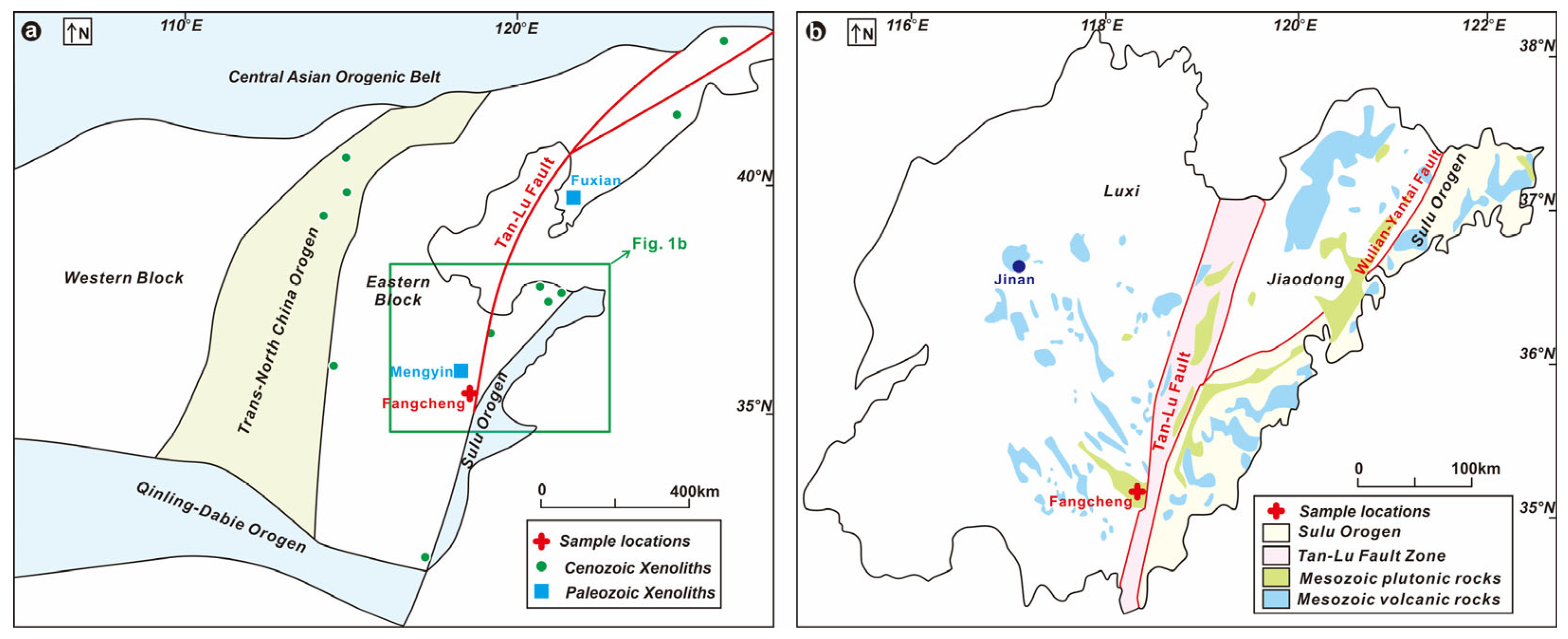



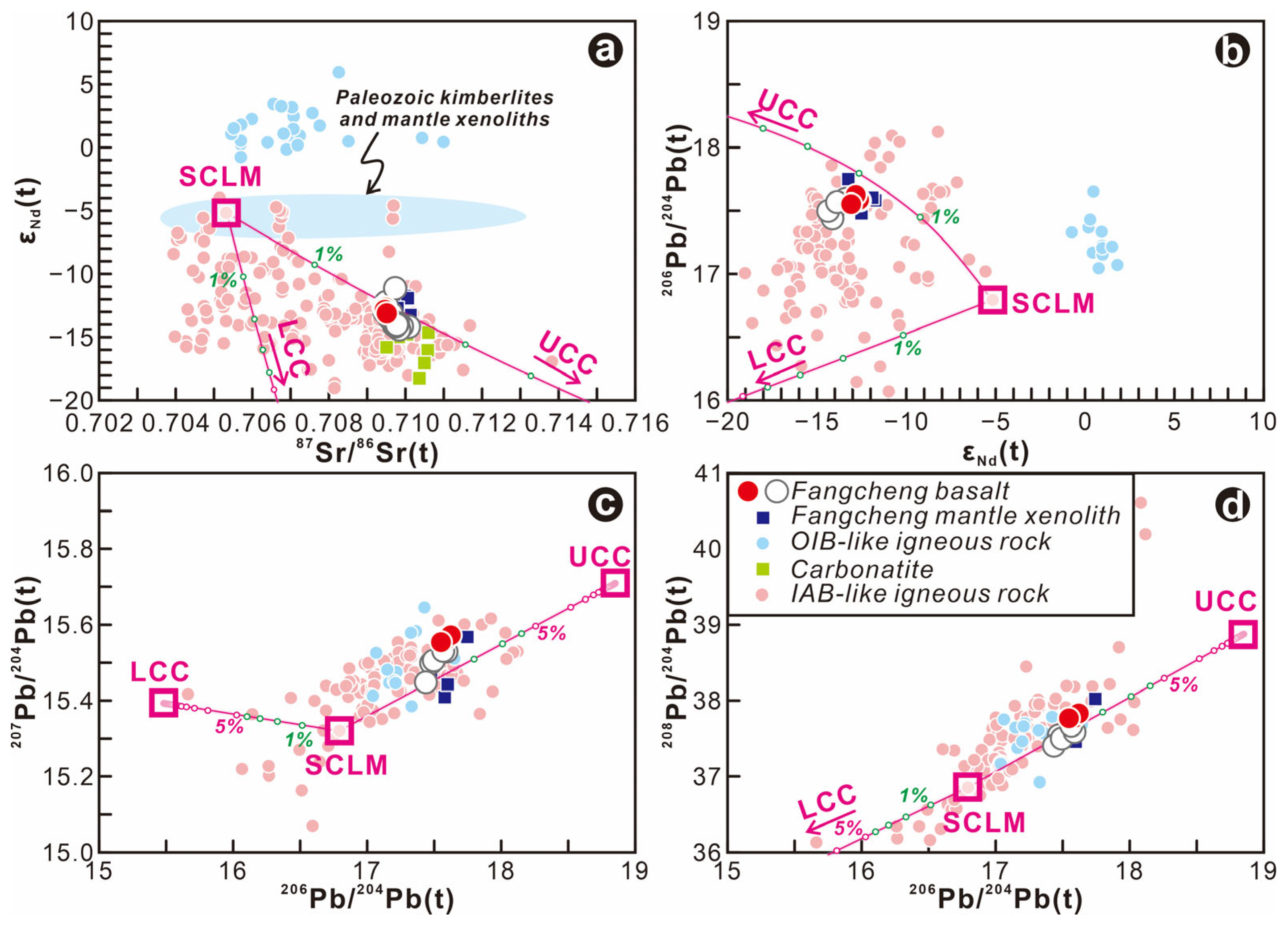
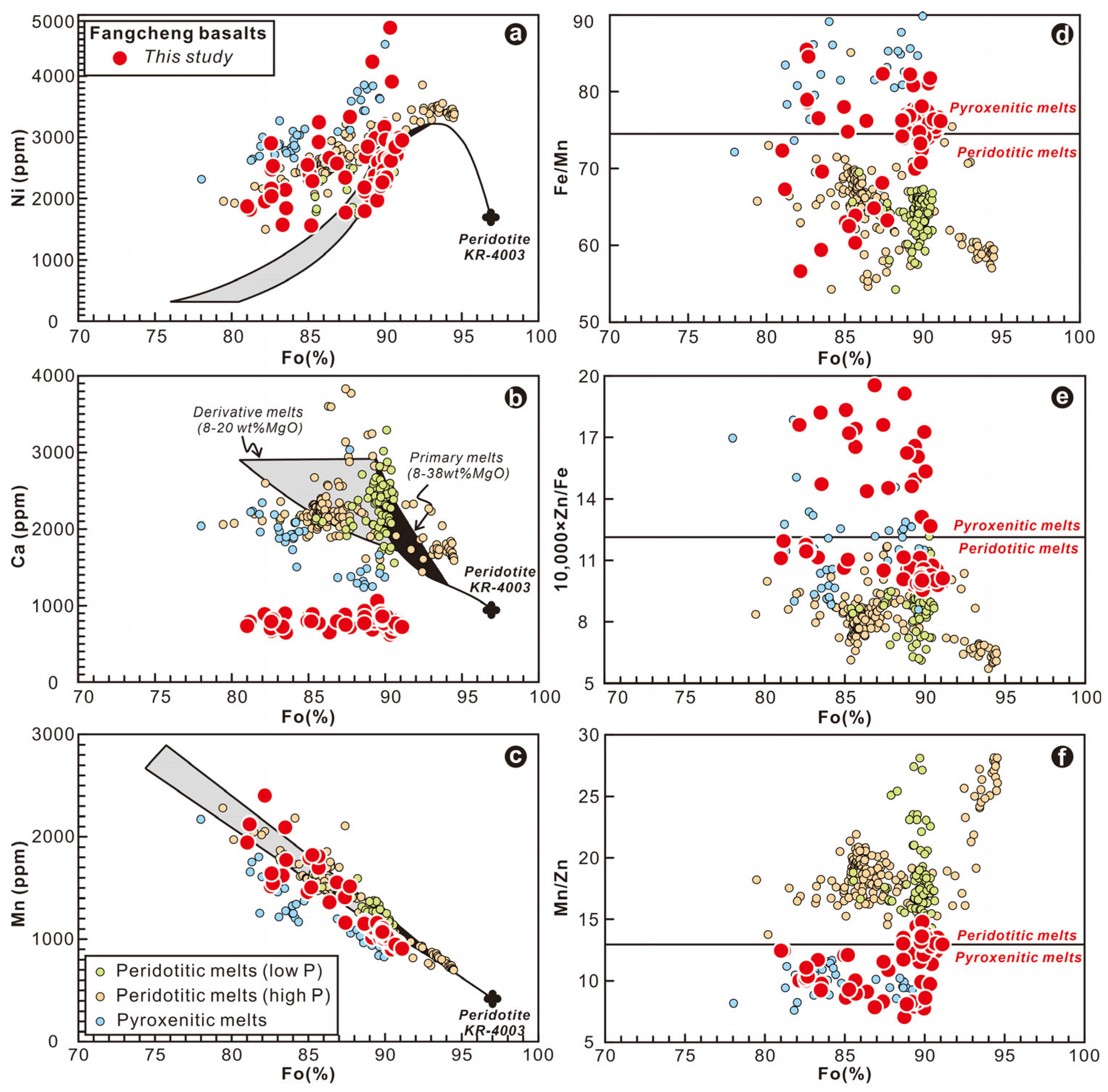



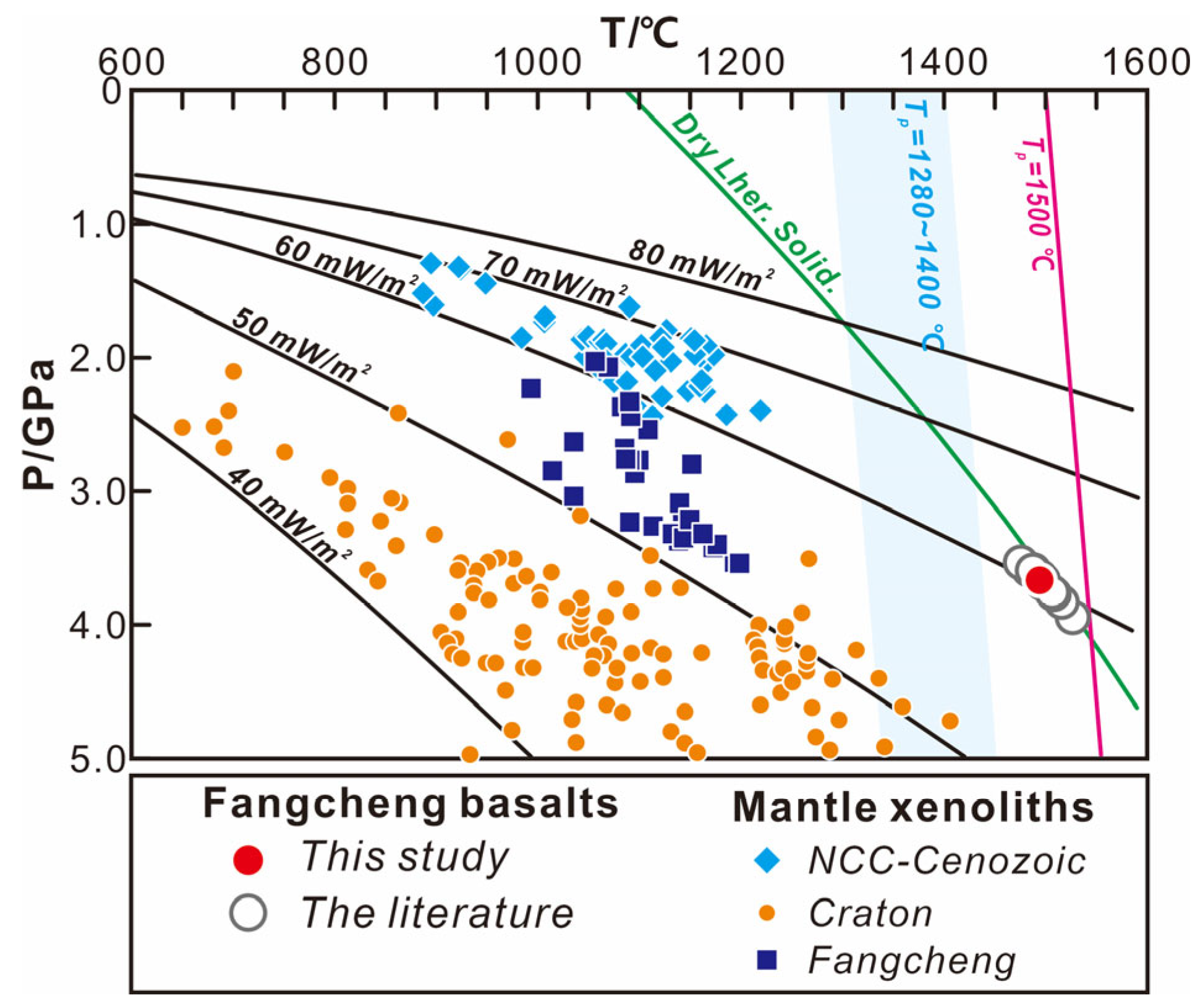
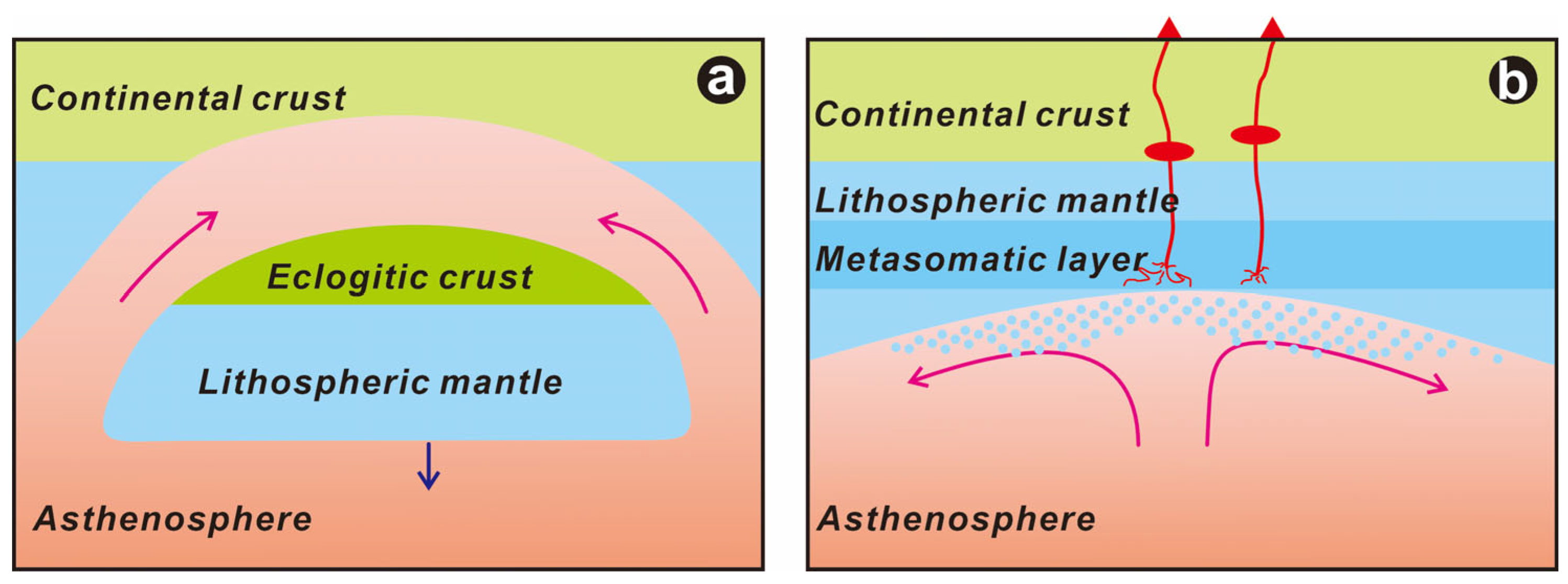
Disclaimer/Publisher’s Note: The statements, opinions and data contained in all publications are solely those of the individual author(s) and contributor(s) and not of MDPI and/or the editor(s). MDPI and/or the editor(s) disclaim responsibility for any injury to people or property resulting from any ideas, methods, instructions or products referred to in the content. |
© 2025 by the authors. Licensee MDPI, Basel, Switzerland. This article is an open access article distributed under the terms and conditions of the Creative Commons Attribution (CC BY) license (https://creativecommons.org/licenses/by/4.0/).
Share and Cite
Qin, Q.-C.; Hong, L.-B.; Zhang, Y.-H.; Yu, H.-X.; Wang, D.; Zhang, L.; He, P.-L. Olivine and Whole-Rock Geochemistry Constrain Petrogenesis and Geodynamics of Early Cretaceous Fangcheng Basalts, Eastern North China Craton. Minerals 2025, 15, 928. https://doi.org/10.3390/min15090928
Qin Q-C, Hong L-B, Zhang Y-H, Yu H-X, Wang D, Zhang L, He P-L. Olivine and Whole-Rock Geochemistry Constrain Petrogenesis and Geodynamics of Early Cretaceous Fangcheng Basalts, Eastern North China Craton. Minerals. 2025; 15(9):928. https://doi.org/10.3390/min15090928
Chicago/Turabian StyleQin, Qiao-Chun, Lu-Bing Hong, Yin-Hui Zhang, Hong-Xia Yu, Dan Wang, Le Zhang, and Peng-Li He. 2025. "Olivine and Whole-Rock Geochemistry Constrain Petrogenesis and Geodynamics of Early Cretaceous Fangcheng Basalts, Eastern North China Craton" Minerals 15, no. 9: 928. https://doi.org/10.3390/min15090928
APA StyleQin, Q.-C., Hong, L.-B., Zhang, Y.-H., Yu, H.-X., Wang, D., Zhang, L., & He, P.-L. (2025). Olivine and Whole-Rock Geochemistry Constrain Petrogenesis and Geodynamics of Early Cretaceous Fangcheng Basalts, Eastern North China Craton. Minerals, 15(9), 928. https://doi.org/10.3390/min15090928





